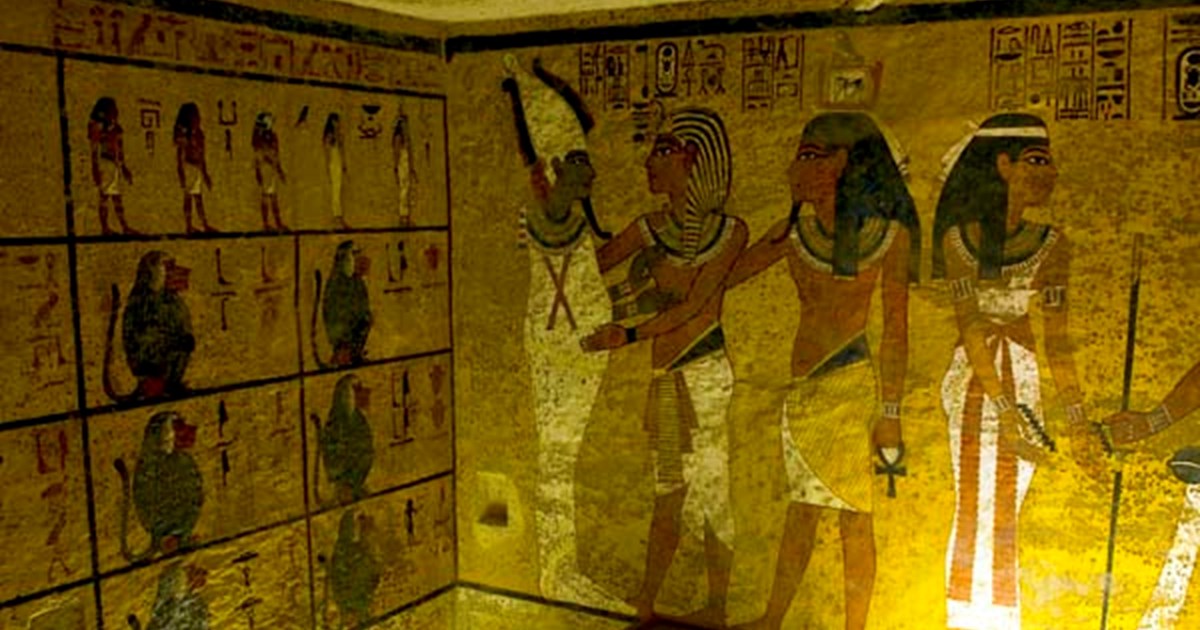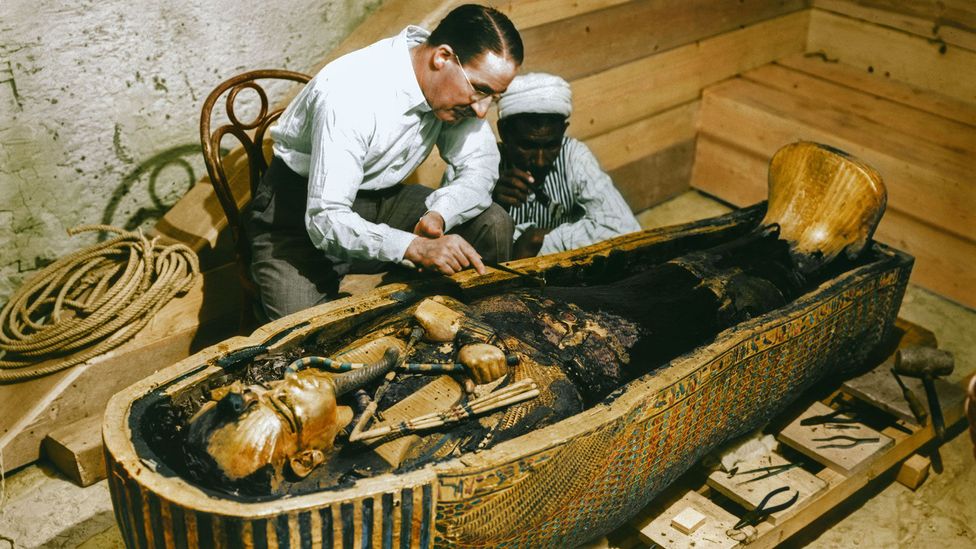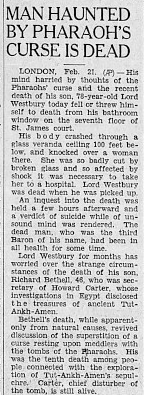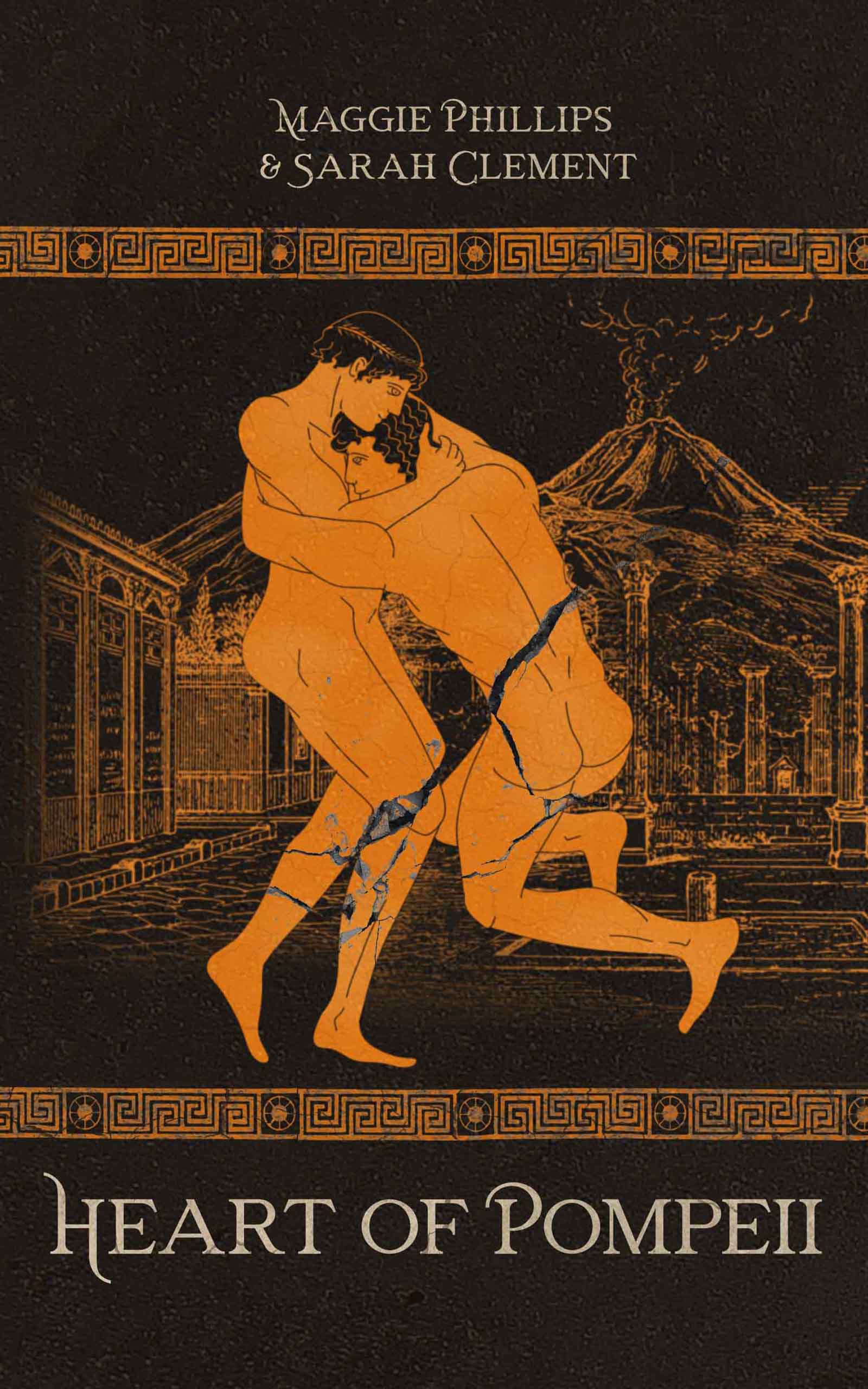Mummies have fascinated popular imagination since the days of their earliest discoveries. Fictionalised accounts of mummies coming back to life have been a staple of the horror genre since 1827 with the publication of ‘The Mummy! A Tale of the 22nd Century’ in which the mummy of Cheops (an actual Egyptian pharaoh) was reanimated. Unlike the shambling undead horrors that stalk and terrorise the usual protagonists in modern media, Cheops is shown as an astute political observer who passes his wisdom on to those who befriend him.
Mummification is not a process limited to Ancient Egypt but it is certainly from there that most popular culture draws when portraying mummies. During the early nineteenth century, the spoils of Egyptian tombs were a source of wonder for the West. Artefacts were put on display, mummies were unwrapped before crowds, and interest surged in all things related to Egyptian culture. This extended to fiction where mummies were increasingly featured as romantic partners for the protagonist until the turn of the century which saw them cast as the villains.
The most common element of horror and mummies is ‘the curse’. Ancient Egyptian tomb is discovered complete with curses promising to wreak havoc on anyone who dares to disturb said tomb. Protagonist does it anyway, curse is unleashed, and often the mummy is reanimated as the means to execute the curse (as well as execute the protagonist).
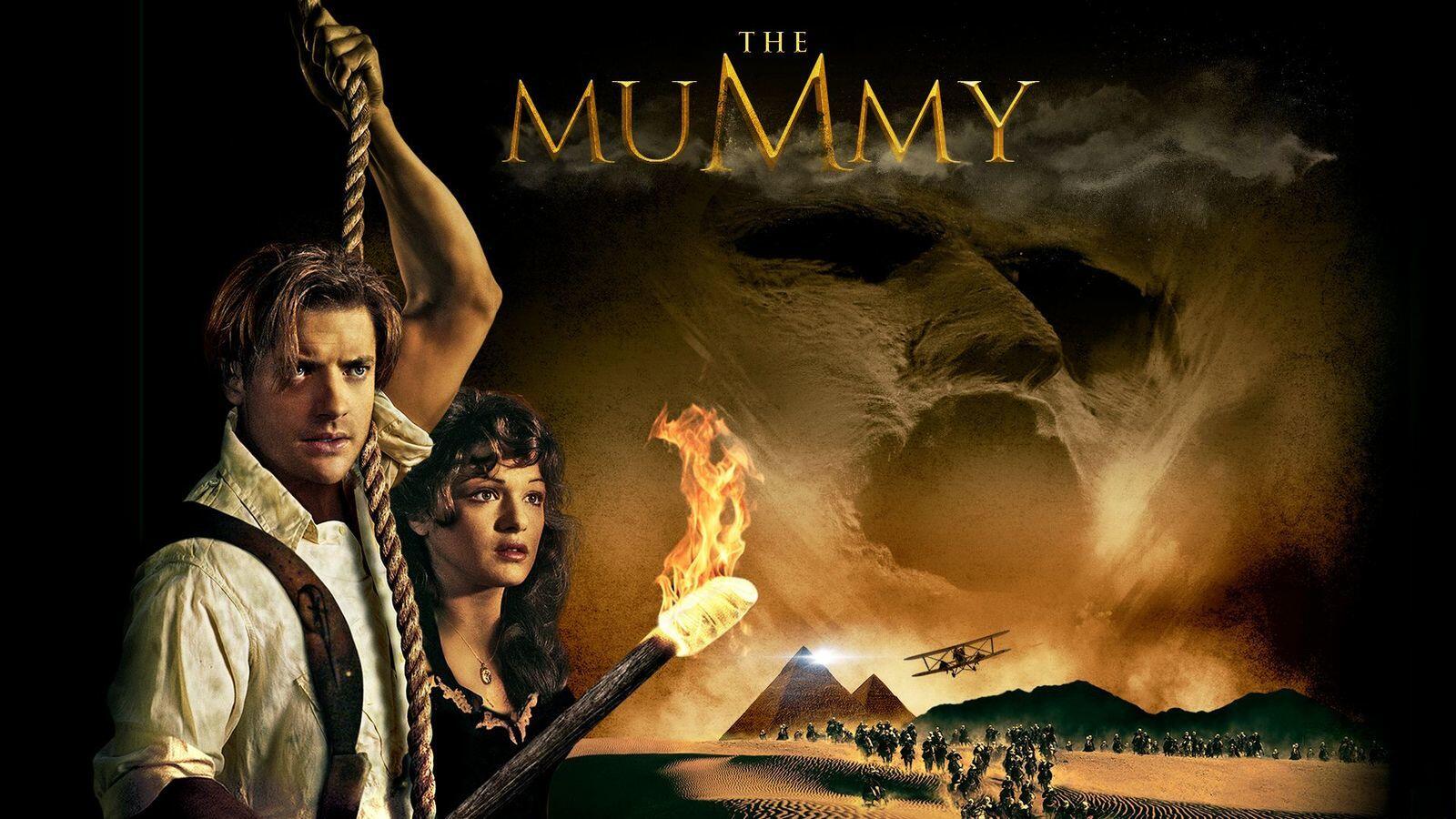
While the roaming undead aren’t usually found within ancient tombs, the notion of a curse is less fantastical. There are examples of curses discovered written within the tombs promising vengeance on anyone who disturbs the deceased. They mostly date to the Old Kingdom and are found in private tombs, becoming less common throughout the ages. Examples include; “any ruler who… shall do evil or wickedness to this coffin… may Hemen not accept any goods he offers, and may his heir not inherit” (Tomb of Ankhtifi 9-10th dynasty) and, “as for all men who shall enter this my tomb… impure… there will be judgment… an end shall be made for him… I shall seize his neck like a bird… I shall cast the fear of myself into him” (Tomb of Khentika 9-10th dynasty).
The threat is obvious and doesn’t distinguish between thieves bent on removing the burial goods and archaeologists bent on… Removing the burial goods. The curses are non-specific and as such their observable effects can be inferred from a brief run of bad luck to catastrophic disaster. A stubbed toe is as likely to be ascribed to a curse as the death of a family member. Statistically, the link between unfortunate incidents and breaking tomb seals is minuscule. Those who have excavated tombs for a living don’t demonstrate any particular rise in bad luck compared to those who haven’t. However, in the light of a curse, mundane and unfortunate coincidences surrounding anyone who has a connection to a disturbed tomb captures the public imagination. As such, there is a wealth of urban legends linking the curse of the pharaohs to the misfortunes of the people who have broken the curse. It’s so deeply rooted in public imagination that there are those that believe that the sinking of the RMS Titanic can be attributed to the mummy it was carrying in its cargo hold.
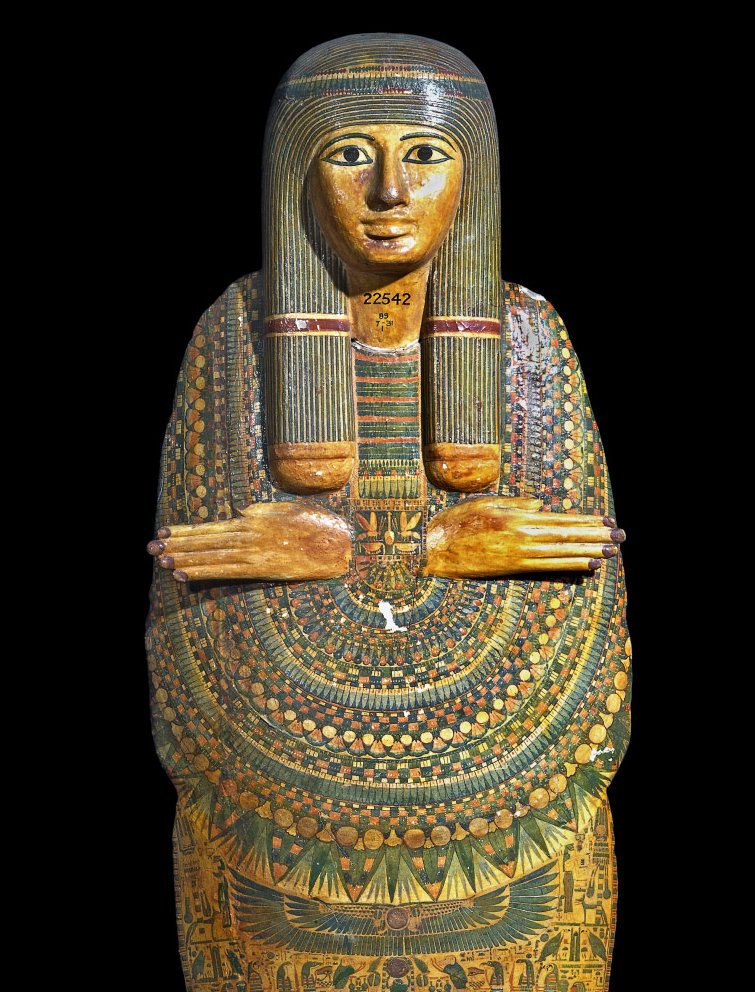
Stories of mummies bringing bad luck to those that come into contact with them actually predate the ability to read the curses themselves. Hieroglyphics weren’t fully deciphered in the West until the mid-nineteenth century while one of the earliest accounts of a cursed mummy dates from over a hundred years earlier in 1699. In his book Traite du Embaumements (Treatise on Embalming), Louis Penicher wrote of a Polish merchant who acquired two mummies during a trip to Alexandria. While returning home aboard a ship, the merchant was plagued with visions of two ghosts while the ship was tormented by sudden and inexplicable storms. In a fit of desperation, the merchant threw the mummies overboard which immediately halted both the visions and the bad weather.
The discovery and excavation of Tutankhamun’s tomb in 1922 by Howard Carter attracted worldwide attention. The story garnered incredible publicity and was a treasure trove not just for the literal treasures within but for the historical significance of the hieroglyphics. The contents of the tomb have given the world some of the most identifiable and iconic images of Ancient Egypt. But the riches and treasures that he discovered would pale in some ways to the story of a curse that plagued the expedition.
The most commonly repeated of curses is some variation of “death will come on swift wings to he who disturbs the tomb of the pharaoh,” and it was this curse that was supposedly discovered at Tutankhamun’s tomb. The location of the curse was initially disputed with rumour attributing it to markings at the tomb’s entrance and/or a small medallion recovered by Carter from within. There was in fact, no curse present anywhere, with the fashion for such things having died out long, long before Tutankhamun reigned.
Despite this, almost immediately there were events which sparked rumours among the locals that the excavation was cursed. When he discovered the tomb, Carter sent a messenger back to his house to deliver the news. Upon arrival, the messenger heard a strange sound inside and opened the door to find Carter’s canary was being attacked and killed by a king cobra; the same kind that adorned many of Tutankhamun’s relics. During the excavation, Carter also reported seeing a jackal, commonly associated with the Egyptian God of the dead, Anubis. He claimed it was the first time he had seen one in the wild despite his almost forty years of excavating in the desert.
Shortly after the tomb was opened and made headlines everywhere, sending the world into a frenzy for everything Ancient Egyptian, Carter’s financier, Lord Carnarvon, died in semi-mysterious circumstances which brought the idea of a curse to the forefront of the public imagination.
George Herbert, 5th Earl of Carnarvon, was an avid Egyptologist and funded a number of Howard Carter’s excavations. He was one of the first to enter the tomb, behind Carter himself, and was present when the tomb was officially opened in November 1922. The following March saw Carnarvon receive a mosquito bite that became infected after it cut while shaving. He died of blood poisoning on the 5th April 1923 at his hotel in Cairo.
Due to Carnarvon’s prominence within the expedition, his presence at the tomb, and the suddenness of his death, it was perhaps inevitable that it would be attributed to a curse. Such rumours were fueled in part when Sir Arthur Conan Doyle, the noted writer who gave us Sherlock Holmes and the fabricated elements of the Marie Celeste, publicly suggested that Carnarvon’s death had been the work of elementals charged with protecting the tomb. Then, studies into Tutankhamun’s remains revealed that he had also received a cut, possibly in the same place as Carnarvon. There were other stories that lent a supernatural air to what was the relatively mundane passing of an ageing man with a chronic lung complaint. At the moment of his death, two things of note were supposed to have occurred. The first was a power cut in Cairo at the moment of Carnarvon’s death, after which two labourers who had uncovered the tomb were supposedly discovered dead. Back in England, the Earl’s dog, Susie, broke out of Carnarvon’s house and started barking wildly at nothing in particular. Or at least, nothing visible to the staff and family who watched her. The dog’s neck was suddenly and inexplicably broken allegedly at the same moment her master’s heart stopped beating.
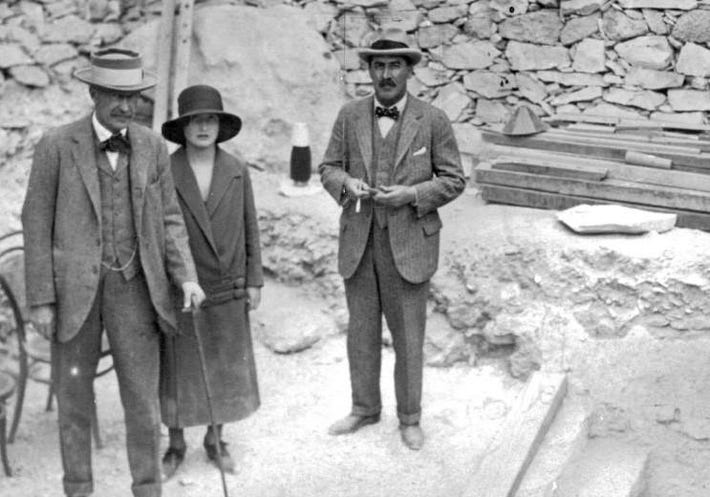
The nurse who attended Carnarvon during his decline died shortly afterwards and his two half-brothers weren’t spared either. In the same year that Carnarvon died, his brother Aubrey Herbert was struck blind. After undergoing an unnecessary operation to have his teeth removed to restore his sight, he developed fatal blood poisoning. Mervyn Herbert, a British diplomat, contracted malaria while visiting Rome and died when it developed into pneumonia. Lady Evelyn Herbert, the Earl’s daughter who had been among those first visitors into the tomb, seemed to elude the curse in that she didn’t die prematurely. She did, however, receive a serious injuries in a car accident which allegedly left her suffering from minor strokes for the rest of her life.
If this wasn’t enough to fuel the legends, misfortune seemed determined to strike those surrounding the tomb. Two representatives of the Egyptian government present at the tomb were murdered after the event. Twenty-two-year-old Prince Ali Kamel Fahmey Bey was killed eight months later by his wife of six months. The following year the Governor-General of Sudan, Sir Lee Stack, was assassinated by a group of Egyptian students.
One of the first visitors to the tomb, railroad executive and financier George Jay Gould, contracted a fever while in the tomb. It developed into pneumonia and he died shortly after his visit despite visiting the French Riviera for his recovery. Egypt’s first Egyptologist. Ahmed Kamal Bey, whose work had allowed excavations like Carter’s to go ahead also visited the tomb and like Gould developed an infection which proved fatal within a manner of months.
Several of those involved in the excavation or the resulting artefacts died before the decade was out. Hugh Evelyn White, one of the first into the tomb would take his own life two years after his entrance and specifically referred to a curse in his suicide note.
I knew there was a curse on me, though I have leave to take those manuscripts to Cairo. The monks told me the curse would work all the same, Now it has done so.
In England, the man responsible for x-raying the recovered mummy, Sir Archibald Douglas Reid, died shortly afterwards after surgery relating to a sudden acute abdominal complaint. Sir Archibald Douglas Arthur Cuttenden Mace worked on the excavation of many of the recovered artefacts and his health started to decline soon after. He left Egypt to recover only to die in 1928 amidst rumours of arsenic poisoning.
Carter’s private secretary Captain Richard Bethell was found smothered in his bed in 1928. Four days later, Edgar Steele who was responsible for handling the artefacts as they arrived at the British Museum died after routine surgery. The following year, Captain Bethell’s father, Lord Westbury, took his own life after jumping from a tall building. He left a cryptic note behind;
“I really cannot stand any more horrors and hardly see what good I am going to do here, so I am making my exit.”
When his belongings were cleared, it was discovered that his son had taken several artefacts from the tomb illegally and given them to his father. The curse was extensively referenced in the press as demonstrated in this story that appeared on the front page of The San Pedro News Pilot.
MAN HAUNTED BY PHARAOH’S CURSE IS DEAD
LONDON, Feb. 21. (JP) His mind harried by thoughts of the Pharaohs’ curse and the recent death of his son, 78-year-old Lord Westbury today fell or threw himself to death from his bathroom window on the seventh floor of St. James court. His body crashed through a glass veranda ceiling 100 feet below. and knocked over a woman there. She was so badly cut by broken glass and so affected by shock it was necessary to take her to a hospital. Lord Westbury was dead when he was picked up. An inquest into the death was held a few hours afterward and a verdict of suicide while of unsound mind was rendered. The dead man, who was the third Baron of his name, had been in all health for some time. Lord Westbury for months has worried over the strange circumstances of the death of his son, Richard Bethell, 46, who was secretary of Howard Carter, whose investigations in Egypt disclosed the treasures of ancient Tut-Ankh-Amen. Bethell’s death, while apparently from natural causes, revived discussion of the superstition of a curse resting upon meddlers with the tombs of the Pharaohs. His was the tenth death among people connected with the exploration of Tut-Ankh-Amen’s sepulchre. Carter, chief disturber of the tomb, is still alive.
The fact that Howard Carter escaped the curse was seen by some as evidence against its existence. After excavating the tomb, Carter wrote three books on the subject and retired from archaeology to act as a dealer in antiquities for a number of museums. He passed away in 1939, at the age of sixty-four of Hodgkin lymphoma. Upon his death, it was discovered that he had several artefacts that had been removed from Tutankhamun’s tomb and used to decorate Carter’s london apartment. These would eventually be returned to Egypt and apparently mark the end of the curse. But while Carter seemed to avoid premature death, severe injury, or bizarre circumstances, there was still speculation that the curse had affected him in other ways.
One of the most common rumours connected Carter with Lord Carnarvon’s daughter, Evelyn. Allegedly, Carter was desperately in love with Evelyn, but she married elsewhere and Carter determined that if he couldn’t marry her then he wouldn’t marry anyone and he lived alone for the duration of his life. Others suggest that they had an affair during her time in Egypt, which ended when her father died and saw Evelyn leave the country and never return. These rumours weren’t contemporary. There was no gossip from their friends and circles that suggested that they’d had a romantic relationship. They met when Evelyn was only six years old and they remained friends for the rest of his life. She was one of only nine people who attended his funeral but she denied ever having an affair with him, barely considering them close friends. A year after the tomb was excavated, she married the politician Sir Brograve Beauchamp with whom she had a daughter. That same year, Beauchamp arrived in Egypt with his parents and without Evelyn, for a tour of the tomb which was conducted by Carter personally.
Carter never married and aside from these posthumous rumours about an affair with Evelyn Herbert, he wasn’t connected to any women romantically or otherwise. While this makes for an interesting story with regards to the curse, his stoicism and general insistence on cultivating as few relationships as possible predates the excavation of the tomb. It seemed that Carter just didn’t like people. A member of staff at the British Museum once claimed to have known something about Carter that he didn’t want to make public which prompted the theory that he was perhaps gay. But Carter wasn’t connected to any men either, romantically or otherwise. It seems he just didn’t like people that much. Hardly a curse and hardly uncommon.
Even those who attribute deaths to the curse on Tutankhamun’s tomb can’t quantify how many might have died from it. The numbers range from four to thirty. Carter never believed in a curse and dismissed any talk of it as superstitious nonsense, aided in his belief by the fact that there was no curse written into the tomb or any part of it. The number of premature and suspicious deaths surrounding the tomb prompted scientific studies into whether archaeologists who excavated such sites were any more at risk to injury than any other job. The studies concluded that if there were curses, their effects were no greater than the general luck experienced by anyone else. Much of the rumours surrounding supposed cursed objects are just that, rumours based on exaggerated stories that have little basis in fact. In which case, the number of people who died startling and premature deaths so soon after visiting the tomb of Tutankhamun can only be considered a remarkable and unlikely coincidence.
It’s not often I have something to say after a post but excuse me while I make an exception. I am absolutely thrilled to announce that my debut novel is now available in paperback and ebook. If you’re interested in queer stories set in the ancient world or if you’d just like to support me you can purchase it here.
If you’d like to join me for more fun and games in picking apart history, and other behind the scene tangents, you can support me via my Patreon.

